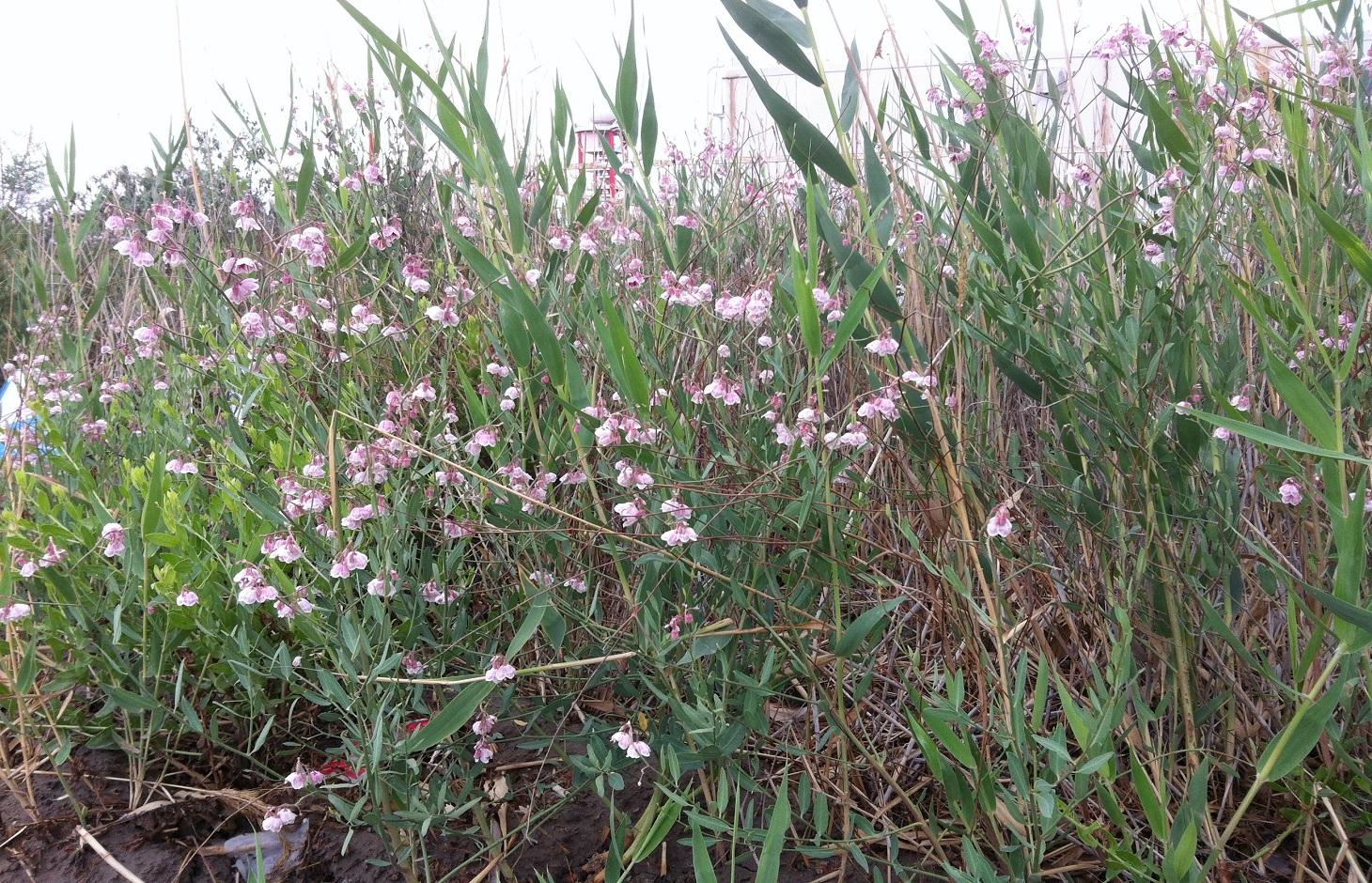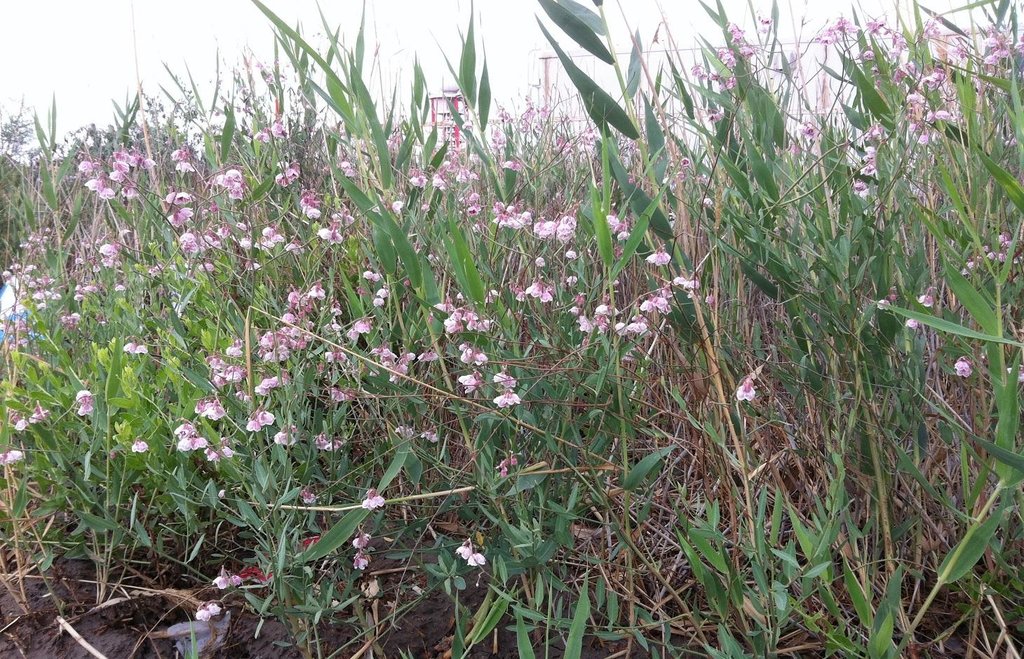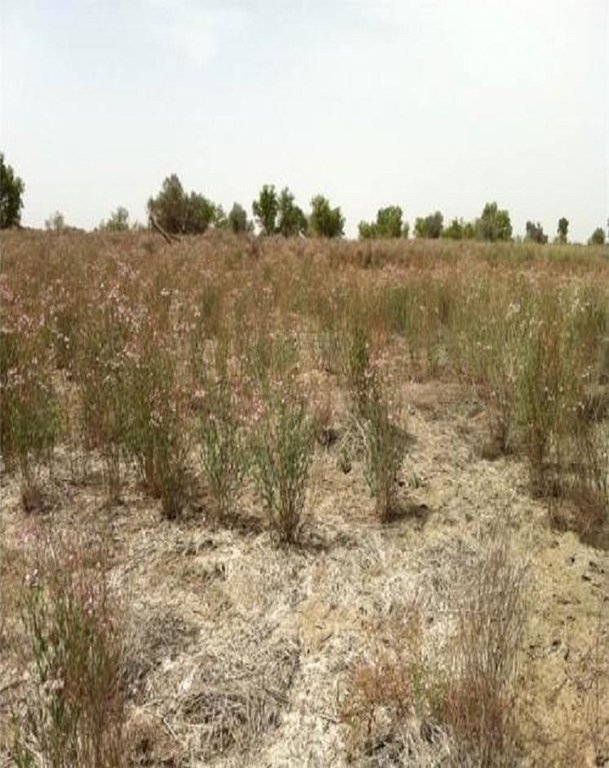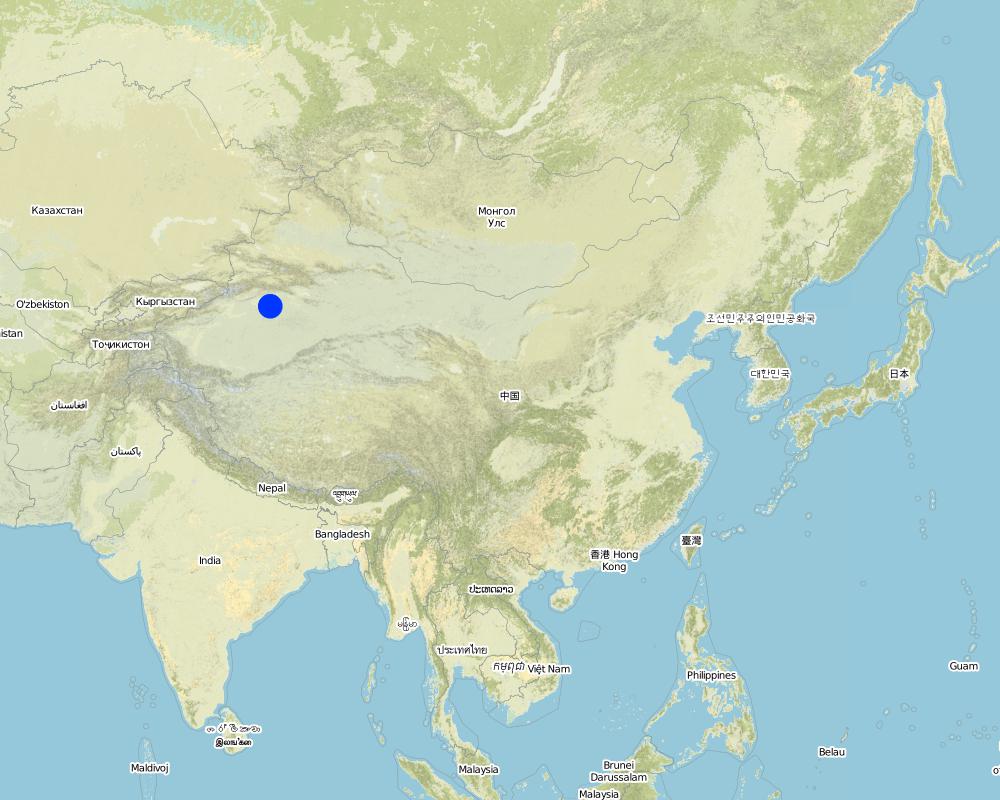Apocynum planting to protect and profit from saline soils in the Tarim River Basin, north-west China [จีน]
- ผู้สร้างสรรค์:
- การอัพเดท:
- ผู้รวบรวม: Christian Rumbaur
- ผู้เรียบเรียง: –
- ผู้ตรวจสอบ: David Streiff, Deborah Niggli, Rima Mekdaschi Studer
罗布红麻 and 罗布百麻 (Chinese)
technologies_1721 - จีน
- บทสรุปทั้งหมดในรูปแบบของ PDF
- บทสรุปทั้งหมดในรูปแบบของ PDF เพื่อพิมพ์
- บทสรุปทั้งหมดในรูปหน้าเว็บ
- บทสรุปทั้งหมด (ไม่มีการจัดเรียง)
- Apocynum planting to protect and profit from saline soils in the Tarim River Basin, north-west China: 9 มีนาคม 2017 (inactive)
- Apocynum planting to protect and profit from saline soils in the Tarim River Basin, north-west China: 4 เมษายน 2018 (inactive)
- Apocynum planting to protect and profit from saline soils in the Tarim River Basin, north-west China: 19 มีนาคม 2019 (public)
ดูส่วนย่อย
ขยายทั้งหมด ย่อทั้งหมด1. ข้อมูลทั่วไป
1.2 รายละเอียดที่ติดต่อได้ของผู้รวบรวมและองค์กรที่เกี่ยวข้องในการประเมินและการจัดเตรียมทำเอกสารของเทคโนโลยี
ผู้เชี่ยวชาญ SLM:
Rouzi Ahmatjan
Catholic University Ingolstadt-Eichstaett
เยอรมนี
ผู้เชี่ยวชาญ SLM:
Thevs Niels
World Agroforestry Center, University of Central Asia
คีร์กีซสถาน
ชื่อของโครงการซึ่งอำนวยความสะดวกในการทำเอกสารหรือการประเมินเทคโนโลยี (ถ้าเกี่ยวข้อง)
Sustainable Management of River Oases along the Tarim River, China (SuMaRiO / GLUES)ชื่อของโครงการซึ่งอำนวยความสะดวกในการทำเอกสารหรือการประเมินเทคโนโลยี (ถ้าเกี่ยวข้อง)
Book project: Making sense of research for sustainable land management (GLUES)ชื่อขององค์กรซึ่งอำนวยความสะดวกในการทำเอกสารหรือการประเมินเทคโนโลยี (ถ้าเกี่ยวข้อง)
Catholic University Ingolstadt-Eichstaett (KU) - เยอรมนีชื่อขององค์กรซึ่งอำนวยความสะดวกในการทำเอกสารหรือการประเมินเทคโนโลยี (ถ้าเกี่ยวข้อง)
International Centre for Research in Agroforestry (ICRAF) - เคนยา1.3 เงื่อนไขการใช้ข้อมูลที่ได้บันทึกผ่านทาง WOCAT
ผู้รวบรวมและวิทยากรหลักยอมรับเงื่อนไขเกี่ยวกับการใช้ข้อมูลที่ถูกบันทึกผ่านทาง WOCAT:
ใช่
2. การอธิบายลักษณะของเทคโนโลยี SLM
2.1 การอธิบายแบบสั้น ๆ ของเทคโนโลยี
คำจำกัดความของเทคโนโลยี:
Plantation of Apocynum pictum and Apocynum venetum as protective and profitable indigenous plants - on soils made saline through irrigation of cotton without adequate drainage.
2.2 การอธิบายแบบละเอียดของเทคโนโลยี
คำอธิบาย:
The natural ecosystems in north-west China, especially in Xinjiang Province, are dominated by steppes, semi-deserts and desert. Riparian forests along the Tarim River Basin have been reduced and degraded by the expansion of irrigated agriculture since the 1950s. The main crop planted is cotton. In the arid temperate cold desert climate, precipitation is very low and evaporation high. The only water source for the region is the Tarim River. Xinjiang is being promoted to become the main cotton production area of China, especially in the upper reaches of the Tarim River, and reservoirs with a large irrigation infrastructure have been established. Farmers water their fields with flood and drip irrigation. But most of the fields have no drainage system. With the high evaporation and the capillary rise of the shallow groundwater, salts dissolved in the water accumulate on the soil surface and in the soil. This salinization makes the fields unusable for cotton production and are abandoned as farmers move on. These barren saline soils are prone to wind erosion, as almost no plants can grow on them. Large-scale desertification is the result.
Purpose of the Technology: To halt desertification the barren saline soils need to be protected by vegetation to avoid soil loss by wind. But if this can be done through vegetation that yields an income then the advantage is double: a win-win situation. Apocynum venetum and Apocynum pictum are indigenous and both are drought and salt tolerant. They are phreatophytes: deep-rooted plants that tap groundwater or the soil layer just above the water table. A.venetum and A. pictum are rhizomatous perennials – and importantly they are cash crops too. Fibre from the stems are used to produce textiles, though the extraction process is time and labor consuming. The advantage of apocynum yarn is that it has antibacterial properties. The leaves and flowers are also sold and used to produce tea which is a Traditional Chinese Medicine (TCM) that reduces blood pressure. On a per hectare basis, the stem generates a potential income of US$ 3,650, the leaves US$ 1,995, and the flowers US$ 1,815: nevertheless the market for apocynum products is small. In Xinjiang most of the apocynum plantations are under commercial large-scale farmers. They have the capital to deal with the costly establishment of apocynum.
Natural / human environment: Fields on which apocynum is sown should have a groundwater level not deeper than 2m. Nevertheless the soil should be well-drained: best is a sandy loam. Waterlogged, calcareous, clayey soils are not suitable. Apocynum can withstand periods of water inundation; however, prolonged submergence or waterlogging inhibits its growth. The topsoil under apocynum is often saline, reaching salt contents of up to 20%. Apocynum can grow on sites with a pronounced surface salinization, as long as the subsoil and the groundwater are not strongly salinized. There are two methods of planting apocynum: by seed or by vegetative means. While irrigation helps establishment and good yields, this is at a much lower level than for cotton. In conclusion, A.venetum and A. pictum provide profitable options on saline soils, grow with minimal irrigation, and protect the land against wind erosion.
2.3 รูปภาพของเทคโนโลยี
2.5 ประเทศภูมิภาค หรือสถานที่ตั้งที่เทคโนโลยีได้นำไปใช้และได้รับการครอบคลุมโดยการประเมินนี้
ประเทศ:
จีน
ภูมิภาค/รัฐ/จังหวัด:
China / Xinjiang Province
ข้อมูลจำเพาะเพิ่มเติมของสถานที่ตั้ง :
Tarim River Basin
ระบุการกระจายตัวของเทคโนโลยี:
- กระจายไปอย่างสม่ำเสมอในพื้นที่
If the Technology is evenly spread over an area, specify area covered (in km2):
6000.0
แสดงความคิดเห็น:
Boundary points of the Technology area: Location in China between 37°~46°N and 76°~104°E. Location in Tarim River Basin: 41°12'34.94"N and 84°19'28.19"E
In China the area of Apocynum vegetation, natural or artificial, amounts to 1,330,000 ha. One third to half of this area is located in Xinjiang, ie approximately 600,000 ha
Map
×2.6 วันที่การดำเนินการ
ถ้าไม่รู้ปีที่แน่นอน ให้ระบุวันที่โดยประมาณ:
- มากกว่า 50 ปี (แบบดั้งเดิม)
2.7 คำแนะนำของเทคโนโลยี
- naturally
3. การจัดประเภทของเทคโนโลยี SLM
3.1 วัตถุประสงค์หลักของเทคโนโลยี
- ลด ป้องกัน ฟื้นฟู การเสื่อมโทรมของที่ดิน
- สร้างผลกระทบทางด้านเศรษฐกิจที่เป็นประโยชน์
3.2 ประเภทของการใช้ที่ดินในปัจจุบันที่ได้นำเทคโนโลยีไปใช้

พื้นที่ปลูกพืช
- การปลูกพืชล้มลุกอายุปีเดียว
- การปลูกพืชยืนต้นที่ไม่มีเนื้อไม้
- การปลูกไม้ยืนต้น ไม้พุ่ม
Annual cropping - Specify crops:
- fibre crops - cotton
- wheat
- Apocynum
จำนวนของฤดูเพาะปลูกต่อปี:
- 1
ระบุ:
Longest growing period in days: 220Longest growing period from month to month: March to October with irrigation
แสดงความคิดเห็น:
Apocynum venetum and Apocynum pictum
Major land use problems (compiler’s opinion): Salinization, desertification, mismanagement of cotton monoculture, inadequate drainage under irrigation, abandonment of degraded land.
Major land use problems (land users’ perception): Water scarcity, salinization, land use rights.
Future (final) land use (after implementation of SLM Technology): Cropland: Ct: Tree and shrub cropping
Constraints of wastelands / deserts / glaciers / swamps: salt crust on the top soil layer and high salt content in the soil
3.3 Has land use changed due to the implementation of the Technology?
Has land use changed due to the implementation of the Technology?
- Yes (Please fill out the questions below with regard to the land use before implementation of the Technology)

พื้นที่ปลูกพืช
- การปลูกพืชล้มลุกอายุปีเดียว

ที่ดินที่ไม่ให้ผลผลิต
ระบุ:
Desertification: Wastelands, deserts, glaciers, swamps, recreation areas, etc
3.4 การใช้น้ำ
การใช้น้ำของที่ดินที่มีการใช้เทคโนโลยีอยู่:
- น้ำฝนร่วมกับการชลประทาน
3.5 กลุ่ม SLM ที่ตรงกับเทคโนโลยีนี้
- แนวกันลมหรือแนวต้านลม
- การปรับปรุงพันธุ์พืชหรือพันธุ์สัตว์ต่าง ๆ
3.6 มาตรการ SLM ที่ประกอบกันเป็นเทคโนโลยี

มาตรการอนุรักษ์ด้วยวิธีพืช
- V1: ต้นไม้และพุ่มไม้คลุมดิน

มาตรการอนุรักษ์ด้วยการจัดการ
- M1: การเปลี่ยนรูปแบบของการใช้ประโยชน์ที่ดิน
แสดงความคิดเห็น:
Main measures: vegetative measures, management measures
Type of vegetative measures: aligned: -graded strips *<sup>3</sup>, scattered / dispersed
3.7 รูปแบบหลักของการเสื่อมโทรมของที่ดินที่ได้รับการแก้ไขโดยเทคโนโลยี

การกัดกร่อนของดินโดยลม
- Et (Loss of topsoil): การสูญเสียดินชั้นบน

การเสื่อมโทรมของดินทางด้านเคมี
- Cs (Salinization/alkalinization): การสะสมเกลือหรือการทำให้เป็นด่าง

การเสื่อมโทรมของดินทางด้านชีวภาพ
- Bc (Reduction of vegetation cover): การลดลงของจำนวนพืชที่ปกคลุมดิน
- Bh (Loss of habitat): การสูญเสียแหล่งที่อยู่
- Bq (Quantity/biomass decline): การลดลงของปริมาณหรือมวลชีวภาพ
- Bs (Quality and species composition): องค์ประกอบหรือความหลากหลายทางคุณภาพและชนิดพันธุ์ลดลง
แสดงความคิดเห็น:
Main type of degradation addressed: Et: loss of topsoil, Cs: salinisation / alkalinisation, Bc: reduction of vegetation cover, Bh: loss of habitats, Bq: quantity / biomass decline, Bs: quality and species composition /diversity decline
Main causes of degradation: soil management (Most fields have no drainage -> Increase of groundwater -> salinisation of soils), crop management (annual, perennial, tree/shrub) (Cotton monocultures), wind storms / dust storms (Duststorms, blow ou tof topsoil), droughts (It is an arid climate), population pressure (doubling the population during the last thirty years), land tenure (land belongs to the state), education, access to knowledge and support services (poorer farmers have less access to extension services)
Secondary causes of degradation: discharges (point contamination of water) (Non-point source pollution and drainage water discharge from the fields), disturbance of water cycle (infiltration / runoff) (Most fields have no drainage -> Increase of groundwater -> salinisation of soils), floods (Floods are necessary for the region (riparian forests)), poverty / wealth (family farmers are poorer than city dwellers)
3.8 การป้องกัน การลดลง หรือการฟื้นฟูความเสื่อมโทรมของที่ดิน
ระบุเป้าหมายของเทคโนโลยีกับความเสื่อมโทรมของที่ดิน:
- ฟื้นฟูบำบัดที่ดินที่เสื่อมโทรมลงอย่างมาก
แสดงความคิดเห็น:
Main goals: rehabilitation / reclamation of denuded land
4. ข้อมูลจำเพาะด้านเทคนิค กิจกรรมการนำไปปฏิบัติใช้ ปัจจัยนำเข้า และค่าใช้จ่าย
4.1 แบบแปลนทางเทคนิคของเทคโนโลยี
ข้อมูลจำเพาะด้านเทคนิค (แบบแปลนทางเทคนิคของเทคโนโลยี):
Apocynum planted in a levelled field with strips of 8 to 18 cm height and 30 to 40 cm width with 40 cm space between each strip
Technical knowledge required for field staff / advisors: moderate (for regeneration and multiplication)
Technical knowledge required for land users: moderate
Main technical functions: improvement of ground cover, stabilisation of soil (eg by tree roots against land slides), promotion of vegetation species and varieties (quality, eg palatable fodder)
Secondary technical functions: reduction in wind speed
Aligned: -graded strips
Vegetative material: C : perennial crops
Number of plants per (ha): 20,000
Vertical interval between rows / strips / blocks (m): 0
Vertical interval within rows / strips / blocks (m): 0.4
Width within rows / strips / blocks (m): 0.3 to 0.4
Scattered / dispersed
Vegetative material: C : perennial crops
Number of plants per (ha): 60,000 to 70,000
Vertical interval between rows / strips / blocks (m): 0.3
Spacing between rows / strips / blocks (m): 0.3
Vertical interval within rows / strips / blocks (m): 0.3
Width within rows / strips / blocks (m): 0.3
Gradient along the rows / strips: 0%
4.2 ข้อมูลทั่วไปเกี่ยวกับการคำนวณปัจจัยนำเข้าและค่าใช้จ่าย
ระบุสกุลเงินที่ใช้คำนวณค่าใช้จ่าย:
- USD
If relevant, indicate exchange rate from USD to local currency (e.g. 1 USD = 79.9 Brazilian Real): 1 USD =:
-0.42
4.3 กิจกรรมเพื่อการจัดตั้ง
| กิจกรรม | Timing (season) | |
|---|---|---|
| 1. | Manuring (3700 to 5000 kg/ha) and ploughing | Before sowing |
| 2. | Site establishment/ preparation | |
| 3. | Planting of seedlings/ root cuttings/ transplants | most suitable seeding time is mid April to May or transplantation |
| 4. | Irrigation at establishment (10000-12000 m3/ha) | After sowing |
4.4 ค่าใช้จ่ายของปัจจัยนำเข้าที่จำเป็นสำหรับการจัดตั้ง
| ปัจจัยนำเข้า | หน่วย | ปริมาณ | ค่าใช้จ่ายต่อหน่วย | ค่าใช้จ่ายทั้งหมดต่อปัจจัยนำเข้า | %ของค่าใช้จ่ายที่ก่อให้เกิดขึ้นโดยผู้ใช้ที่ดิน | |
|---|---|---|---|---|---|---|
| แรงงาน | Site establishment/ preparation | ha | 2.0 | 18.7 | 37.4 | 100.0 |
| วัสดุด้านพืช | Seeds | ha | 100.0 | 2.5 | 250.0 | |
| วัสดุด้านพืช | Seedlings | ha | 100.0 | 6.18 | 618.0 | |
| อื่น ๆ | Manure | ha | 171.1 | 18.7 | 3199.57 | 100.0 |
| อื่น ๆ | Waterfee | - | 1.0 | 460.0 | 460.0 | 100.0 |
| ค่าใช้จ่ายทั้งหมดของการจัดตั้งเทคโนโลยี | 4564.97 | |||||
| Total costs for establishment of the Technology in USD | -10868.98 | |||||
แสดงความคิดเห็น:
Duration of establishment phase: 15 month(s)
4.5 การบำรุงรักษาสภาพหรือกิจกรรมที่เกิดขึ้นเป็นประจำ
| กิจกรรม | ช่วงระยะเวลา/ความถี่ | |
|---|---|---|
| 1. | irrigation and weeding labor | 6 times |
| 2. | Fertilizer | |
| 3. | Harvest labor | at harvest |
| 4. | Transport | after harvest |
4.6 ค่าใช้จ่ายของปัจจัยนำเข้าและกิจกรรมที่เกิดขึ้นเป็นประจำที่ต้องการการบำรุงรักษา (ต่อปี)
| ปัจจัยนำเข้า | หน่วย | ปริมาณ | ค่าใช้จ่ายต่อหน่วย | ค่าใช้จ่ายทั้งหมดต่อปัจจัยนำเข้า | %ของค่าใช้จ่ายที่ก่อให้เกิดขึ้นโดยผู้ใช้ที่ดิน | |
|---|---|---|---|---|---|---|
| แรงงาน | irrigation and weeding labor | ha | 10.0 | 114.0 | 1140.0 | 100.0 |
| แรงงาน | Harvest labor | ha | 1.0 | 359.0 | 359.0 | 100.0 |
| อุปกรณ์ | Transport | ton | 1.0 | 11.0 | 11.0 | 100.0 |
| ปุ๋ยและสารฆ่า/ยับยั้งการเจริญเติบโตของสิ่งมีชีวิต (ไบโอไซด์) | Fertilizer (Phosporus) | kg | 150.0 | 4.12 | 618.0 | |
| อื่น ๆ | Waterfee | 1.0 | 2280.0 | 2280.0 | ||
| ค่าใช้จ่ายทั้งหมดของการบำรุงรักษาสภาพเทคโนโลยี | 4408.0 | |||||
| Total costs for maintenance of the Technology in USD | -10495.24 | |||||
แสดงความคิดเห็น:
Machinery/ tools: hoe, shovel, tractor and plough
Costs were calculated for 2015, per hectare. Labour has become more expensive over the last few years. In the beginning (first two years) cultivation of apocynum is very labour and input intensive. After 1.5 to 2 years the plants can be harvested for the first time. The price for the products of apocynum (leafs and stems) are very high. Direct seeding as compared to vegetative propagation is the most labour-saving method to cultivate apocynum.
5. สิ่งแวดล้อมทางธรรมชาติและของมนุษย์
5.1 ภูมิอากาศ
ฝนประจำปี
- < 250 ม.ม.
- 251-500 ม.ม.
- 501-750 ม.ม.
- 751-1,000 ม.ม.
- 1,001-1,500 ม.ม.
- 1,501-2,000 ม.ม.
- 2,001-3,000 ม.ม.
- 3,001-4,000 ม.ม.
- > 4,000 ม.ม.
ข้อมูลจำเพาะ/ความคิดเห็นเรื่องปริมาณน้ำฝน:
Per year: 90 mm; Jan, Feb, Apr, May: 3 mm; Mar, Sept: 5mm; Jun: 33 mm; Jul: 18 mm; Oct: 0 mm; Dec: 8 mm
เขตภูมิอากาศเกษตร
- แห้งแล้ง
Thermal climate class: temperate. cold desert climate
5.2 สภาพภูมิประเทศ
ค่าเฉลี่ยความลาดชัน:
- ราบเรียบ (0-2%)
- ลาดที่ไม่ชัน (3-5%)
- ปานกลาง (6-10%)
- เป็นลูกคลื่น (11-15%)
- เป็นเนิน (16-30%)
- ชัน (31-60%)
- ชันมาก (>60%)
ธรณีสัณฐาน:
- ที่ราบสูง/ที่ราบ
- สันเขา
- ไหล่เขา
- ไหล่เนินเขา
- ตีนเนิน
- หุบเขา
ระดับความสูง:
- 0-100 เมตร
- 101-500 เมตร
- 501-1,000 เมตร
- 1,001-1,500 เมตร
- 1,501-2,000 เมตร
- 2,001-2,500 เมตร
- 2,501-3,000 เมตร
- 3,001-4,000 เมตร
- > 4,000 เมตร
ให้ระบุถ้าเทคโนโลยีได้ถูกนำไปใช้:
- ไม่เกี่ยวข้อง
ความคิดเห็นและข้อมูลจำเพาะเพิ่มเติมเรื่องสภาพภูมิประเทศ:
Altitudinal zone: Altitude between 800 and 1300 m
5.3 ดิน
ค่าเฉลี่ยความลึกของดิน:
- ตื้นมาก (0-20 ซ.ม.)
- ตื้น (21-50 ซ.ม.)
- ลึกปานกลาง (51-80 ซ.ม.)
- ลึก (81-120 ซ.ม.)
- ลึกมาก (>120 ซ.ม.)
เนื้อดิน (ดินชั้นบน):
- หยาบ/เบา (ดินทราย)
- ปานกลาง (ดินร่วน ทรายแป้ง)
อินทรียวัตถุในดิน:
- ต่ำ (<1%)
(ถ้ามี) ให้แนบคำอธิบายเรื่องดินแบบเต็มหรือระบุข้อมูลที่มีอยู่ เช่น ชนิดของดิน ค่า pH ของดินหรือความเป็นกรดของดิน ความสามารถในการแลกเปลี่ยนประจุบวก ไนโตรเจน ความเค็ม เป็นต้น:
Soil fertility: low - medium
Soil drainage / infiltration: medium
Soil water storage capacity: medium - high
5.4 ความเป็นประโยชน์และคุณภาพของน้ำ
ระดับน้ำใต้ดิน:
5-50 เมตร
น้ำไหลบ่าที่ผิวดิน:
ดี
คุณภาพน้ำ (ที่ยังไม่ได้บำบัด):
เป็นน้ำเพื่อการดื่มที่ไม่ดี (จำเป็นต้องได้รับการบำบัด)
ความคิดเห็นและข้อมูลจำเพาะเพิ่มเติมเรื่องคุณภาพและปริมาณน้ำ:
Ground water table also < 5 m: Apocynum is a phreatophyte. The most productive sites of Apocynum venetum are found on a groundwater not deeper than 3 m with salt contets between 1g/l and 10g/l.
Ground water table 5-50 m: Apocynum pictum is mainly found on groundwater levels of 4-6m below surface with a maximum groundwater depth of 8 m. Apocynum is restricted to groundwater levels not deeper than 4 m below surface.
5.5 ความหลากหลายทางชีวภาพ
ความหลากหลายทางชนิดพันธุ์:
- ปานกลาง
5.6 ลักษณะของผู้ใช้ที่ดินที่นำเทคโนโลยีไปปฏิบัติใช้
แนวทางการตลาดของระบบการผลิต:
- ทำการค้า/การตลาด
รายได้ที่มาจากนอกฟาร์ม:
- < 10% ของรายได้ทั้งหมด
ระดับของความมั่งคั่งโดยเปรียบเทียบ:
- รวย
- รวยมาก
เป็นรายบุคคล/ครัวเรือน:
- กลุ่ม/ชุมชน
ระดับของการใช้เครื่องจักรกล:
- งานที่ใช้แรงกาย
- การใช้เครื่องจักรหรือเครื่องยนต์
เพศ:
- ชาย
ระบุลักษณะอื่นๆที่เกี่ยวข้องของผู้ใช้ที่ดิน:
Land users applying the Technology are mainly common / average land users
Difference in the involvement of women and men: Man are doing the hard work in the fields, women do more the harvesting
Population density: 10-50 persons/km2
Annual population growth: > 4%; 7%
5% of the land users are very rich and own 10% of the land.
20% of the land users are rich and own 30% of the land.
40% of the land users are average wealthy and own 30% of the land.
30% of the land users are poor and own 20% of the land.
5% of the land users are poor and own 10% of the land.
Off-farm income specification: The plantation of Apocynum brings a high income to the farmers.
Level of mechanization manual labour: harvesting
Market orientation of production system commercial/ market: Apocynum is planted for fibre, tea and medicinal products
Level of mechanization mechanized/motorized: field preparation
5.7 Average area of land used by land users applying the Technology
- < 0.5 เฮกตาร์
- 0.5-1 เฮกตาร์
- 1-2 เฮกตาร์
- 2-5 เฮกตาร์
- 5-15 เฮกตาร์
- 15-50 เฮกตาร์
- 50-100 เฮกตาร์
- 100-500 เฮกตาร์
- 500-1,000 เฮกตาร์
- 1,000-10,000 เฮกตาร์
- >10,000 เฮกตาร์
พิจารณาว่าเป็นขนาดเล็ก กลาง หรือขนาดใหญ่ (ซึ่งอ้างอิงถึงบริบทระดับท้องถิ่น):
- ขนาดกลาง
แสดงความคิดเห็น:
< 0.5 ha: family farms
5-15 ha: state farms
5.8 กรรมสิทธิ์ในที่ดิน สิทธิในการใช้ที่ดินและสิทธิในการใช้น้ำ
กรรมสิทธิ์ในที่ดิน:
- รัฐ
สิทธิในการใช้ที่ดิน:
- เกี่ยวกับชุมชน (ถูกจัดระเบียบ)
- เช่า
สิทธิในการใช้น้ำ:
- เกี่ยวกับชุมชน (ถูกจัดระเบียบ)
- เช่า
แสดงความคิดเห็น:
All the land belongs to the state. Farmers have the right to use the land for 70 years.
5.9 การเข้าถึงบริการและโครงสร้างพื้นฐาน
สุขภาพ:
- จน
- ปานกลาง
- ดี
การศึกษา:
- จน
- ปานกลาง
- ดี
ความช่วยเหลือทางด้านเทคนิค:
- จน
- ปานกลาง
- ดี
การจ้างงาน (เช่น ภายนอกฟาร์ม):
- จน
- ปานกลาง
- ดี
ตลาด:
- จน
- ปานกลาง
- ดี
พลังงาน:
- จน
- ปานกลาง
- ดี
ถนนและการขนส่ง:
- จน
- ปานกลาง
- ดี
น้ำดื่มและการสุขาภิบาล:
- จน
- ปานกลาง
- ดี
บริการด้านการเงิน:
- จน
- ปานกลาง
- ดี
6. ผลกระทบและสรุปคำบอกกล่าว
6.1 ผลกระทบในพื้นที่ดำเนินการ (On-site) จากการใช้เทคโนโลยี
ผลกระทบทางด้านเศรษฐกิจและสังคม
การผลิต
การผลิตพืชผล
การผลิตไม้
การเสี่ยงต่อความล้มเหลวในการผลิต
ความหลากหลายของผลิตภัณฑ์
พื้นที่สำหรับการผลิต
ความเป็นประโยชน์และคุณภาพของน้ำ
ความต้องการน้ำจากการชลประทาน
รายได้และค่าใช้จ่าย
ค่าใช่จ่ายของปัจจัยการผลิตทางการเกษตร
รายได้จากฟาร์ม
ความหลากหลายของแหล่งผลิตรายได้
ภาระงาน
ผลกระทบทางด้านเศรษฐกิจและสังคมอื่น ๆ
market for apocynum fibre
market for TCM
ผลกระทบด้านสังคมวัฒนธรรมอื่น ๆ
โอกาสทางวัฒนธรรม
โอกาสทางด้านสันทนาการ
การบรรเทาความขัดแย้ง
Livelihoods and human well-being
ผลกระทบด้านนิเวศวิทยา
วัฐจักรน้ำหรือน้ำบ่า
ปริมาณน้ำ
คุณภาพน้ำ
การระบายน้ำส่วนเกิน
ดิน
ความชื้นในดิน
สิ่งปกคลุมดิน
การสูญเสียดิน
การเกิดแผ่นแข็งที่ผิวดิน /การเกิดชั้นดาน
อินทรียวัตถุในดิน/ต่ำกว่าดินชั้น C
ความหลากหลายทางชีวภาพของพืชและสัตว์
มวลชีวภาพ/เหนือดินชั้น C
ความหลากหลายทางชีวภาพของพืช
ความหลากหลายของสัตว์
ลดความเสี่ยงของภัยพิบัติ
ความเร็วของลม
6.2 ผลกระทบนอกพื้นที่ดำเนินการ (Off-site) จากการใช้เทคโนโลยี
การเกิดมลพิษในน้ำบาดาลหรือแม่น้ำ
ตะกอนที่ถูกพัดพามาโดยลม
6.3 การเผชิญและความตอบสนองของเทคโนโลยีต่อการเปลี่ยนแปลงสภาพภูมิอากาศที่ค่อยเป็นค่อยไป และสภาพรุนแรงของภูมิอากาศ / ภัยพิบัติ (ที่รับรู้ได้โดยผู้ใช้ที่ดิน)
การเปลี่ยนแปลงสภาพภูมิอากาศที่ค่อยเป็นค่อยไป
การเปลี่ยนแปลงสภาพภูมิอากาศที่ค่อยเป็นค่อยไป
| ฤดู | increase or decrease | เทคโนโลยีมีวิธีการรับมืออย่างไร | |
|---|---|---|---|
| อุณหภูมิประจำปี | เพิ่มขึ้น | ไม่ทราบ |
สภาพรุนแรงของภูมิอากาศ (ภัยพิบัติ)
ภัยพิบัติทางอุตุนิยมวิทยา
| เทคโนโลยีมีวิธีการรับมืออย่างไร | |
|---|---|
| พายุฝนประจำท้องถิ่น | ดี |
| พายุลมประจำท้องถิ่น | ดี |
ภัยพิบัติจากสภาพภูมิอากาศ
| เทคโนโลยีมีวิธีการรับมืออย่างไร | |
|---|---|
| ภัยจากฝนแล้ง | ดี |
ภัยพิบัติจากน้ำ
| เทคโนโลยีมีวิธีการรับมืออย่างไร | |
|---|---|
| น้ำท่วมตามปกติ (แม่น้ำ) | ไม่ค่อยดี |
ผลลัพธ์ตามมาที่เกี่ยวข้องกับภูมิอากาศอื่น ๆ
ผลลัพธ์ตามมาที่เกี่ยวข้องกับภูมิอากาศอื่น ๆ
| เทคโนโลยีมีวิธีการรับมืออย่างไร | |
|---|---|
| ช่วงการปลูกพืชที่ลดลงมา | ไม่ทราบ |
6.4 การวิเคราะห์ค่าใช้จ่ายและผลประโยชน์ที่ได้รับ
ผลประโยชน์ที่ได้รับเปรียบเทียบกับค่าใช้จ่ายในการจัดตั้งเป็นอย่างไร (จากมุมมองของผู้ใช้ที่ดิน)
ผลตอบแทนระยะสั้น:
ด้านลบ
ผลตอบแทนระยะยาว:
ด้านบวกอย่างมาก
ผลประโยชน์ที่ได้รับเปรียบเทียบกับค่าใช้จ่ายในการบำรุงรักษาหรือต้นทุนที่เกิดขึ้นซ้ำอีก เป็นอย่างไร (จากมุมมองของผู้ใช้ที่ดิน)
ผลตอบแทนระยะสั้น:
ด้านลบเล็กน้อย
ผลตอบแทนระยะยาว:
ด้านบวกอย่างมาก
แสดงความคิดเห็น:
In the beginning (first two years) the plantation of Apocynum is very labour and input intensive. After 1.5 to 2 yearsthe plants can be harvested for the first time. The price for the producst of Apocynum (leafs and stems) are very high.
6.5 การปรับตัวของเทคโนโลยี
ถ้ามีข้อมูลให้บอกปริมาณด้วย (จำนวนของครัวเรือนหรือครอบคลุมพื้นที่):
No number on households
Of all those who have adopted the Technology, how many did so spontaneously, i.e. without receiving any material incentives/ payments?
- 91-100%
แสดงความคิดเห็น:
100% of land user families have adopted the Technology without any external material support
Comments on spontaneous adoption: Most of the plantations are planted by large investing farmers. The farmers sell the products of Apocynum to the pharmaceutical companies for Traditional Chinese Medicine (TCM)
There is a little trend towards spontaneous adoption of the Technology
6.7 จุดแข็ง / ข้อได้เปรียบ / โอกาสของเทคโนโลยี
| จุดแข็ง / ข้อได้เปรียบ / โอกาสในทัศนคติของผู้รวบรวมหรือวิทยากรหลัก |
|---|
|
Both species yield fibres and leaves for fiber production and the leaves for medicinal products or tea on considerable areas under the arid climate of Xinjiang Province, China, without intensive irrigation, because they use the groundwater as for example cotton. Furthermore, both species can withstand higher soil salinization levels than cotton. How can they be sustained / enhanced? The plantations can be enhanced by analyzing the water consumption and the water use efficiency to apply only as much water to the plants as they need Not decreasing the yields. |
|
Both species can provide an income to local people - fibre and leaves for medicinal products or tea - under conditions which are unfavorable to grow crops under irrigation. How can they be sustained / enhanced? Promote apocynum on saline wastelands and subsidize the establishment of the plantations. Explore further markets and promote the products. |
|
Through apocynum plantations wastelands are reclaimed. How can they be sustained / enhanced? Highlight the potential to reduce wind erosion and ‘dust bowls’. |
6.8 จุดอ่อน / ข้อเสียเปรียบ / ความเสี่ยงของเทคโนโลยีและวิธีการแก้ไข
| จุดอ่อน / ข้อเสียเปรียบ / ความเสี่ยงในทัศนคติของผู้รวบรวมหรือวิทยากรหลัก | มีวิธีการแก้ไขได้อย่างไร |
|---|---|
| Difficult process to extract fibre from the stems. | New technology needs to be developed. |
| Small market. | New uses need to be explored to expand the market. |
| High investment in the beginning of the plantation. | Planting of apocynum should be subsidized. |
7. การอ้างอิงและการเชื่อมต่อ
7.1 วิธีการและแหล่งข้อมูล
7.2 การอ้างอิงถึงสิ่งตีพิมพ์
หัวข้อ, ผู้เขียน, ปี, หมายเลข ISBN:
N Thevs et al. (2012) Apocynum venetum L. and Apocynum pictum Schrenk (Apocynaceae) as multi-functional and multi-service plant species in Central Asia: a review on biology, ecology, and utilization.
ชื่อเรื่อง ผู้เขียน ปี ISBN:
Journal of Applied Botany and Food Quality 85, 159-167.
ลิงก์และโมดูล
ขยายทั้งหมด ย่อทั้งหมดลิงก์
ไม่มีลิงก์
โมดูล
ไม่มีโมดูล





